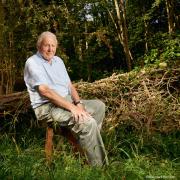Cathryn Kuhfeld on being inspired by nature – and the mouse that got away
Cathryn Kuhfeld’s studio is in a 19th-century brick building overlooking her garden in Wye. She has been here for nearly 28 years and also lived and worked in London for a decade.
Trained at Canterbury College of Art, Cathryn followed up her foundation year with an Honours degree at Bath Academy of Art and a three-year Royal Academy Schools postgraduate course in London. She won two scholarships, one to Italy, and has been able to exhibit ever since.
Cathryn feels that formal art training is invaluable. “Painting and most art forms are solitary pursuits, so time spent learning and studying in the company of fellow students and tutors, with the constant exchange of ideas this always produces, is not to be missed.”
Preceding her art training, Cathryn had an epiphany “of sorts”. She left school at 17, painted for six months and this crystallised her desire to go to art college.
I ask her about her artist’s day. “It’s pretty boring really!” she laughs. “Usually I get up and walk the dog, have breakfast and then get into the studio. I stop for lunch and then carry on. If there’s an exhibition coming up I may continue after supper. I work about six hours a day minimum, plus weekends, although of course sometimes I have to catch up on other stuff, like life and the laundry!”
Cathryn paints in several genres, but the work I have seen mostly encompasses the nature which is all around her. “Over the years I have moved in and out of different phases, a natural progression,” she says.
“I did figurative, then landscape and some abstraction, then nudes but with an abstract mood and colour. When I went to the RA, the first term was drawing and because of that I got more into the figure.”
Now, she adds: “Mood and subject can dictate which direction you go in. Subject matter usually comes along as a result of ideas being developed. Or something will capture your imagination and as a result a whole body of work will evolve from it.
“A recent example of how these things happen is when a wood mouse got into our house. A few days later our dog jumped up and got very excited in the kitchen. On investigating, I moved some baskets and out ran the mouse: the dog promptly caught it in his mouth, from which I extracted a startled and stunned little mouse.”
This was the catalyst for drawing and from there a series of small paintings developed. As an accomplished painter, Cathryn’s work may be highly detailed, as are the mouse paintings, or of a ‘looser’ nature, as her canvases of the chicken run are.
She mostly uses oil paint: “You can’t beat it for versatility. I also use pastels a lot, which I also find very adaptable. The sizes I work on vary enormously. For instance I might be doing some life-size nudes but then do some very small intimate ones. Presently I’m painting a lot of birds and they vary from small to large canvases. With the wood mouse paintings, the very subject matter dictated that they had to be small.”
The challenge is to keep the painting fresh “I don’t want it to end up feeling too staged, it needs to be kept vigorous and spontaneous. On the other hand, I like the quality of the Old Masters, the way for instance that Botticelli’s Primavera has three dancing figures, but they’re quite controlled and staged.”
Along with Botticelli, Cathryn’s other artistic heroes include Pisanello, Uccello, Giorgione, moving on to Gauguin, Van Gogh and Matisse. “Probably the thing that links them all and which appeals to me is pattern and colour.”
Were Cathryn to have one colour only in which to paint, it would be sepia, which comes from the ink of the cuttlefish. “It’s a wonderful dark brown and can produce a wide chiaroscuro.”
“Painting is important, it has a restorative and spiritual place in our lives. It is no coincidence that throughout history most art forms, painting, fresco, sculpture and architecture have their origins in decorating or illustrating all the world’s places of worship and the stories of the religions and beliefs of all peoples. The spiritual side of painting cannot be overestimated.”
Cathryn’s advice to a young artist is to keep everything, destroy nothing: “Even the ‘not very good’ might generate some really good work.” Cathryn welcomes visits by appointment.
Get in touch
Cathryn Kuhfeld, The Corner House, Upper Bridge Street, Wye TN25 5AW, 01233 812287 or 07763 130389
Cathryn is holding Open Studios between 12 March and 6 April.
w



























